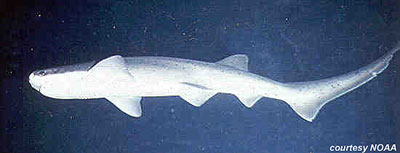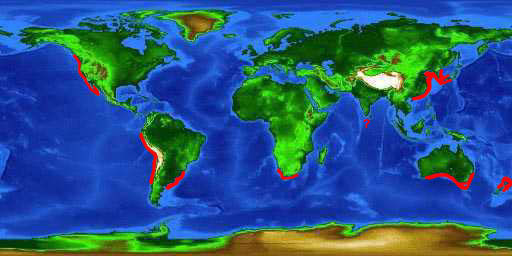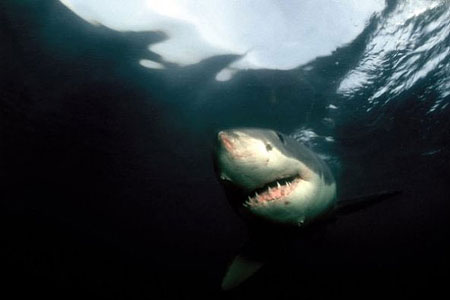Sevengill Shark

Notorynchus cepedianus
These large cowsharks have thick bodies with wide, blunt snouts and a single small dorsal fin set far along their backs. They are silver gray to brown on top, and white underneath, and scattered with white and black spots over their bodies and fins. They have seven gill slits instead of five like most sharks, and can grow to almost ten feet long.
Order – Hexanchiformes
Family – Hexanchidae
Genus – Notorynchus
Species – cepedianus
Common Names
English language common names include sevengill shark, bluntnose sevengill shark, broad snouted sevengill, broadnose sevengill shark, broad-snout, cowshark, ground shark, Pacific seven-gill shark, seven-gill cowshark, sevengill shark, seven-gilled shark, spotted cow shark, spotted seven-gilled shark, and Tasmanian tiger shark. Other common names include cação-bruxa (Portuguese), cañabota gata (Spanish), ebisuzame (Japanese), gatita (Spanish), gevlekte zevenkieuwshaai (Dutch), kammzähner (German), koeihaai (Afrikaans), k’wet’thenéchte (Salish), minami-ebisuzame (Japanese), platneus-sewekiefhaai (Afrikaans), platnez (French), requin malais (French), Siebenkiemiger Pazifischer Kammzähner (German), siedmioszpar plamisty (Polish), tiburón de 7 gallas (Spanish), tiburón pinto (Spanish), tollo fume (Spanish), and tuatini (Maori).
Importance to Humans
In some regions, the sevengill shark is used for human consumption, liver oil and leather. It is commercially and recreationally harvested throughout its range in the eastern Pacific Ocean, from British Colombia to southern California (U.S.), as well as in Australian waters. This shark is often taken as incidental bycatch in the driftnet and trawl fisheries off the coast of California. Anglers are able to catch the sevengill shark from the shoreline due to its shallow water habitat.
Danger to Humans
The sevengill shark is aggressive when provoked and is considered potentially dangerous to humans. According to the International Shark Attack File, the sevengill shark has been responsible for five documented unprovoked attacks on humans since the 16th century. This species has attacked divers in captivity when kept in aquaria.
When caught by fishers, this shark thrashes and snaps and is often subdued with firearms before being landed to avoid human injury.
Conservation
During the 1930s and 1940s, the sevengill shark was quite common in the shark fisheries along the coast of California. Although the commercial fishery soon collapsed, recreational shark fishing for this species became popular. However, this fishery declined in the late 1980s and 1990s with recreational fishers targeting other species. Today the sevengill shark is caught primarily by anglers as well as incidental bycatch in commercial fisheries targeting other species.
Currently, the California population of sevengill sharks appears to be concentrated in the Humboltd and San Francisco Bays. These two areas provide nursery areas and safe havens for juveniles. The future of the sevengill shark in this region is highly dependent upon the conservation of these habitats.
Although this shark has a wide range, it is subject to intense fishing pressure as a result of being restricted to inshore waters. Currently the World Conservation Union (IUCN) lists the sevengill shark as “Data Deficient”. Data is lacking in most regions, making it difficult to determine the overall status of this species. However, it is currently assessed as “Near Threatened” in the eastern Pacific Ocean.
> Check the status of the sevengill shark at the IUCN website.
Geographical Distribution

The sevengill shark is found in all oceans with the exception of the north Atlantic Ocean and the Mediterranean Sea. In the southwestern Atlantic Ocean, it is found from southern Brazil to northern Argentina and in the southeastern Atlantic Ocean it is distributed from Namibia to South Africa. The range of the sevengill shark in the Pacific Ocean is in the western basin from southern Japan south to New Zealand, including Australia and in the eastern region from British Colombia, Canada south to Chile. It has been documented in waters off India, however this record may be incorrect.
Habitat
Large sevengill sharks are often found in offshore waters to depths of 1,870 feet (570 m). However, this species also lives in deep channels in bays. Smaller individuals reside in shallow water over continental shelves including bays and estuaries. Sevengill sharks prefer rocky bottom habitats although they commonly occur over sandy and muddy substrates. The majority of the time, the sevengill shark swims slowly along the bottom substrate while occasionally cruising to the surface.
Biology

Distinctive Features
This shark is a large, active cowshark with a broad head, small eyes, and short, blunt snout. It gets its common name from the seven gills on each side of the pectoral fins. This character distinguishes from most other sharks that have only five gills. There is one dorsal fin that is located far back on the body, from over the insertion to over the free tops of the pelvic fins. The anal fin is smaller than the dorsal fin.
A similar species, the sharpnose sevengill shark (Heptranchias perlo) can be distinguished by the lack of black spots on the body as well as the larger eye size and the smaller body size when compared to the sevengill shark.
Coloration
The body is counter-shaded, an adaptation that allows the shark to blend in with its environment. The upper side is silver-gray to brownish, allowing the shark to blend in with the dark marine waters when viewed from above. The underside is light in color, which blends the shark in with the surface of the water when viewed from below. This coloration pattern is common among many species of predatory sharks. The body and fins have small black and white speckles. Young individuals may have white edges on the trailing edges of the fins and a black stripe from the caudal peduncle to the caudal tip.

Dentition
The dentition of the sevengill shark includes wide, large, comb-shaped teeth in the lower jaw used for tearing and cutting into prey. The teeth in the upper jaw are sharp and jagged, effective at holding thrashing prey. Near the symphysis in the upper jaw, the teeth have narrow cusps and small cusplets with the teeth becoming wider and more comb-shaped moving toward the corners of the jaw. The tooth count is 15-16 in the upper jaw and 13 in the lower jaw.
Size, Age, and Growth
The maximum published length of the sevengill shark is 9.8 feet (3 m) total length and the maximum reported weight is 236 pounds (107 kg). Males reach maturity at 4.9 feet (1.5 m) in length while females become mature at approximately 7.2 feet (2.2 m). The life expectancy of this species is about 50 years.
Food Habits
The sevengill shark, an opportunistic predator, feeds on most anything including sharks, rays, chimaeras, and marine mammals such as dolphins, porpoises, and seals. It also consumes mammalian carrion including humans. It also feeds on bony fishes including salmon, sturgeon, herring, and anchovies among others.
Sevengill sharks sometimes hunt in packs, working as a team to capture large prey such as marine mammals and other sharks. Another hunting tactic is to sneak up on prey from behind, quickly dashing at the last moment for the capture.
Reproduction
The mode of reproduction in the sevengill shark is ovoviviparity. The eggs hatch within the female’s body with the embryos receiving nourishment via a yolksac inside the uterus. When the yolksac is depleted, the embryos absorb nutrients from secretions within the uterus until they are born. The females move into shallow bays to give birth after a 12 month gestation period. This occurs during the spring and early summer months. Each litter may number up to 82 pups, each measuring about 16-18 inches (40-45 cm) in length. Throughout the first few years, the young sharks remain in the shallow water nursery grounds before moving to offshore environments.

Predators
Large predatory sharks are potential predators of the sevengill shark; the white shark (Carcharodon carcharias) is one such documented predator. There has also been reports of cannibalism within this species.
Taxonomy
Péron originally described the sevengill shark as Squalus cepedianus in 1807. However, he later renamed this species Notorynchus cepedianus (1807), which is the currently valid name. The genus name Notorynchus is derived from the Greek “noton” meaning back and “rhyngchos” meaning snout.
Synonyms referring to this species in past scientific literature include Notorynchus platycephalus Tenore 1809, Squalus platycephalus Tenore 1809, Notorhynchus platycephalus Tenore 1809, Heptanchus indicus Agassiz 1838, Notorynchus indicus Agassiz 1838, Notorhychus maculatus Ayres 1855, Notorynchus maculatum Ayres 1855, Notorynchus maculatus Ayres 1855, Notorhynchus borealis Gill 1864, Heptrachias pectorosus Garman 1884, Heptranchus pectorosus Garman 1884, Heptranchias pectorosus Garman 1884, Notorynchus pectorosus Garman 1884, Notidanus ferox Perez Canto 1886, Heptranchias haswelli Ogilby 1897, Notidanus medinaePhilippi 1902, Notidanus wolniczkyi Philippi 1902, Heptranchias spilotus Lahille 1913, Notorhynchus ocellatus Devincenci 1920, and Notorynchus macdonaldi Whitley 1931.
Prepared by: Cathleen Bester